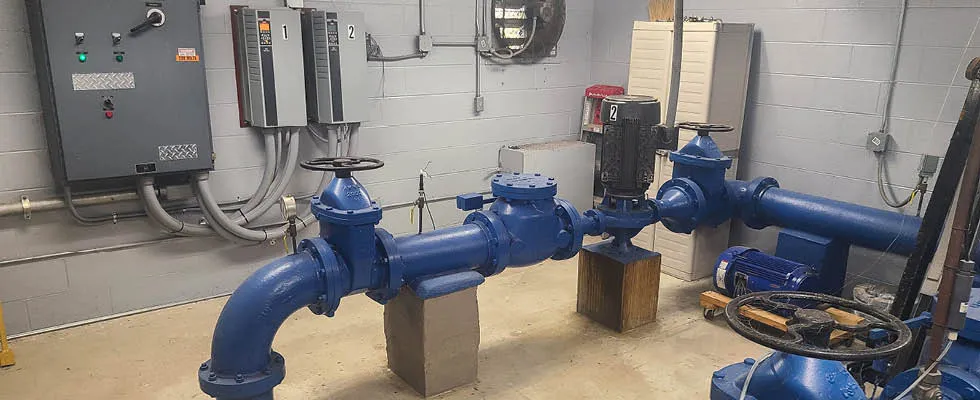- Using Variable Frequency Drives (VFDs) to Avoid Service Disruption
- Advanced Intelligence and Efficiency of VFDs
- Dedicated Pump-Specific Features of VFDs
- Condition-Based Monitoring (CBM) for Early Issue Detection
- Sustaining Infrastructure with VFD Technology
- Modulating Motor Speed for Optimal Pump Flow
- Post-Repair Benefits of VFDs
- Cost-Effective Solutions for Rural Municipalities
Using Variable Frequency Drives (VFDs) to Avoid Service Disruption
In early 2023, the Warren County Utility District (WCUD) in middle Tennessee encountered a significant challenge. The water tank in their Short Mountain (SM) pressure zone required cleaning and repairs to meet federal compliance regulations. However, with only one tank servicing this zone—typical of many rural areas—they faced the problem of how to maintain water service during the tank’s downtime. WCUD oversees a 4.0 million gallons per day (mgd) water treatment plant, six storage tanks, and four remote pump stations distributed across four pressure zones, managing approximately 650 miles of mains to serve 9,000 users in rural Warren and five adjacent counties.
To prevent a service disruption affecting around 400 users in the SM zone, WCUD implemented variable frequency drives (VFDs). The chosen VFDs included proportional integral and derivative control (PID), which maintains discharge pressure in a closed-loop system. By installing the VFD and discharge pressure transducers on the booster pumps, WCUD successfully maintained water service with adequate pressure in the SM zone while the tank was out of service for three weeks. Instead of relying on the tank, the VFD effectively converted the booster pump, typically used to fill the SM tank, into the primary water supply source for the zone.
Advanced Intelligence and Efficiency of VFDs
The VFD installed at WCUD offers built-in intelligence specifically designed for water and wastewater applications. Its variable speed technology allows it to adjust to daily load variations in treatment plants and pumping stations. This motor control on pumps and blowers reduces energy consumption and operating costs. Additionally, the VFD minimizes equipment wear and tear, leading to lower maintenance costs and a longer lifespan.
Dedicated Pump-Specific Features of VFDs
The VFD comes equipped with dedicated pump-specific features such as cascade control, deragging, drive pump detection, end of curve detection, motor alternation, two-stage ramps for submersible or vertical turbine pumps, pipe fill mode, and smart logic controllers. These features provide tailored process control to meet the diverse demands of water and wastewater plants. The VFD’s soft start capabilities in lift station applications further reduce wear on pumps during startup and shutdown, cutting maintenance expenses.
Condition-Based Monitoring (CBM) for Early Issue Detection
Through condition-based monitoring (CBM), the VFD functions as a smart sensor, monitoring motor and application conditions to detect issues early. This early detection allows station personnel to address problems before they impact plant performance, leveraging technologies like edge computing, motor stator winding condition monitoring, mechanical vibration monitoring, and load envelope monitoring. For municipalities with limited resources, this early detection is crucial. Additionally, the lack of a cloud subscription requirement mitigates cybersecurity risks.
Sustaining Infrastructure with VFD Technology
The WCUD general manager highlighted that the installation and programming process took less than a day, and the soft start capability ensured a seamless operational transition.
During the cleaning and repairs, the VFD allowed the pump to maintain water supply to the SM zone at the programmed discharge pressure, even with the tank out of service. The drive was connected to a discharge pressure transducer, creating a feedback loop to the VFD.
Modulating Motor Speed for Optimal Pump Flow
With its variable speed technology, the VFD modulates motor speed to control pump flow and maintain the set discharge pressure. When flow increases and pressure drops, the drive speeds up; when flow decreases and pressure rises, the drive slows down.
For three weeks, the booster pumps ran continuously, effectively becoming the sole source of water and pressure control for the SM zone, thanks to the VFD. Consequently, the 400 users served by the station experienced no water disruptions.
Post-Repair Benefits of VFDs
Post-repairs, the VFD continues to provide significant benefits. Its soft startup reduces the power spike from motor startups and improves the power factor in daily operations, reducing energy consumption. Additionally, the VFD acts as a system backup, ensuring that if any issues arise with the tank, the pump will continue operating and water will keep flowing to users.
Cost-Effective Solutions for Rural Municipalities
Rural municipalities often face challenges due to limited financial resources and equipment, particularly when tanks require maintenance. However, implementing VFDs offers a cost-effective and energy-efficient solution to maintain water services and infrastructure.
